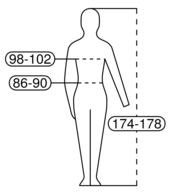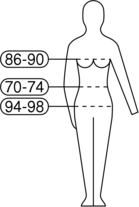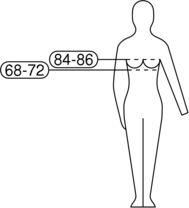
Welcome to OnlineConversion.com
The European Clothing Standard
EN 13402
EN 13402 is a European standard for labeling clothes sizes. It is based on body dimensions, measured in centimetres. It aims to replace many older national dress-size systems, starting in the year 2006.
There are three approaches for size-labeling of clothes:
- body dimensions: The product label states for which range of body dimensions the product was designed. (Example: bike helmet labeled "head girth: 56–60 cm", shoe labeled "foot length: 28 cm")
- product dimensions: The label states characteristic measures of the product. (Example: jeans labeled with their inner-leg length in centimeters or inches, i.e. not the – several centimeters longer – inner leg length of the intended wearer)
- ad-hoc size: The label provides a size number or code with no obvious relationship to any measurement. (Example: Size 12, XL)
Traditionally, clothes have been labeled using many different ad-hoc size systems. This approach has led to a number of problems:
- Country-specific or even vendor-specific labels create additional costs.
- Ad-hoc sizes have changed with time, often due to "vanity labeling", an inflation in body dimensions associated with a size, to avoid confronting aging customers with uncomfortable anthropometric truths.
- Mail-order purchasing requires accurate methods for predicting the best-fitting size.
- Many garments need to be selected based on two or three body dimensions to fit adequately, and not a single scalar.
- Scalar ad-hoc sizes based on 1950s anthropometric studies are no longer adequate, as changes in nutrition and life styles have shifted the distribution of body dimensions.
Therefore, the European standards body CEN started in 1996 the process of designing a new modern system of labeling clothes sizes, resulting in the standard EN 13402 "Size designation of clothes".
It is based on
- body-dimensions
- the metric system
- data from new anthropometric studies of the European population performed in the late 1990s
- similar existing international standards (ISO 3635, etc.)
EN 13402-1: Terms, definitions and body measurement procedure
The first part of the standard defines the list of body dimensions to be used for designating clothes sizes, together with an anatomical explanation and measurement guidelines:
- head girth
- maximum horizontal girth of the head measured above the ears
- neck girth
- girth of the neck measured with the tape measure passed 2 cm below the Adam's apple and at the level of the 7th cervical vertebra
- chest girth
- maximum horizontal girth measured during normal breathing with the subject standing erect and the tape-measure passed over the shoulder blades (scapulae), under the armpits (axillae), and across the chest
- bust girth
- maximum horizontal girth measured during normal breathing with the subject standing erect and the tape-measure passed horizontally, under the armpits (axillae), and across the bust prominence (preferably measured with moderate tension over a brassiere that shall not deform the breast in an unnatural way and shall not displace its volume)
- underbust girth
- horizontal girth of the body measured just below the breasts
- waist girth
- girth of the natural waistline between the top of the hip bones (iliac crests) and the lower ribs, measured with the subject breathing normally and standing erect with the abdomen relaxed
- hip girth
- horizontal girth measured round the buttocks at the level of maximum circumference
- height
- vertical distance between the crown of the head and the soles of the feet, measured with the subject standing erect without shoes and with the feet together (for infants not yet able to stand upright: length of the body measured in a straight line from the crown of the head to the soles of the feet)
- inside leg length
- distance between the crotch and the soles of the feet, measured in a straight vertical line with the subject erect, feet slightly apart, and the weight of the body equally distributed on both legs
- arm length
- distance, measured using the tape-measure, from the armscye/shoulder line intersection (acromion), over the elbow, to the far end of the prominent wrist bone (ulna), with the subject's right fist clenched and placed on the hip, and with the arm bent at 90°
- hand girth
- maximum girth measured over the knuckles (metacarpals) of the open right hand, fingers together and thumb excluded
- foot length
- horizontal distance between perpendiculars in contact with the end of the most prominent toe and the most prominent part of the heel, measured with the subject standing barefoot and the weight of the body equally distributed on both feet
- body mass
- measured with a suitable balance in kilograms
These dimensions are meant to be measured preferably without or as few as possible clothes.
All body dimensions are measured in centimeters, except for the body mass.
The standard also defines a pictogram that can be used in language-neutral labels to indicate one or several of the above body dimensions.
EN 13402-2: Primary and secondary dimensions
The second part of the standard defines for each type of garment one "primary dimension". This is the body measure according to which the product must be labelled.
For some types of garment, a single measure may not be sufficient to select the right product. In these cases, one or two "secondary dimensions" can be added to the label.
The following table shows the primary and secondary dimensions listed in the standard. Secondary dimensions are shown in parenthesis.
| Garment | Men | Women | Boys | Girls |
|---|---|---|---|---|
| Jackets | chest girth (height, waist girth) |
bust girth (height, hip girth) |
height (chest girth) |
height (bust girth) |
| Suits | chest girth, waist girth (height, inside leg length) |
bust girth (height, hip girth) |
height (chest girth) |
height (bust girth) |
| Overcoats | chest girth (height) |
bust girth (height) |
height (chest girth) |
height (bust girth) |
| Trousers/shorts | waist girth (height, inside leg length) |
waist girth (height, hip girth, inside leg length) |
height (waist girth) |
height (waist girth) |
| Skirts | — | waist girth (height, hip girth) |
— | height (waist girth) |
| Dresses | — | bust girth (height, hip girth, waist girth) |
— | height (bust girth) |
| Knits: cardigans, sweaters, T-shirts | chest girth (height) |
bust girth (height) |
height (chest girth) |
height (bust girth) |
| Shirts | neck girth (height, arm length) |
— | height (neck girth) |
— |
| Blouses | — | bust girth (height) |
— | height (bust girth) |
| Underpants | waist girth (height) |
waist girth (height, hip girth) |
height (waist girth) |
height (waist girth) |
| Vest | chest girth (height) |
bust girth (height) |
height (chest girth) |
height (bust girth) |
| Pyjamas Ladies' nightdresses |
chest girth (height, waist girth) |
bust girth (height, waist girth, hip girth) |
height (chest girth) |
height (bust girth) |
| Swim-suits/wear and bodies | waist girth (height, chest girth) |
bust girth (height, hip girth, underbust girth) |
height (chest girth, waist girth) |
height (underbust girth, bust girth) |
| Bras | — | underbust girth, bust girth (cup size) |
— | underbust girth, bust girth (cup size) |
| Corsetry/upper and full body | — | underbust girth, bust girth (height, hip girth, waist girth) |
— | — |
| Corsetry/lower body | — | waist girth, hip girth (height) |
— | — |
| Pantyhose | — | height (waist girth, weight) |
height | height |
| Stockings | — | foot length | ||
| Socks | foot length | |||
| Gloves | hand girth | |||
| Head wear | head girth | |||
EN 13402-3: Measurements and intervals
The third part of the standard defines preferred numbers of primary and secondary body dimensions.
The product should not be labeled with the average body dimension for which the garment was designed (i.e., not "height: 176"). Instead, the label should show the range of body dimensions from half the step size below to half the step size above the design size (e.g., "height: 172-180").
For heights, for example, the standard recommends generally to use the following design dimensions, with a step size of 8 cm:
| Height | ... | 160 | 168 | 176 | 184 | 192 | 200 | ... |
|---|---|---|---|---|---|---|---|---|
| Range | ... | 156-164 | 164-172 | 172-180 | 180-188 | 188-196 | 196-204 | ... |
For trousers, the recommended step size for height is 4 cm:
| Height | ... | 156 | 160 | 164 | 168 | 172 | 176 |
|---|---|---|---|---|---|---|---|
| Range | ... | 154-158 | 158-162 | 162-166 | 166-170 | 170-174 | 174-178 |
| Height | 180 | 184 | 188 | 192 | 196 | 200 | ... |
|---|---|---|---|---|---|---|---|
| Range | 178-182 | 182-186 | 186-190 | 190-194 | 194-198 | 198-202 | ... |
The standard defines similar tables for other dimensions and garments, only some of which are shown here.
Men
The standard sizes and ranges for chest and waist girth are:
| Chest girth | 84 | 88 | 92 | 96 | 100 | 104 | 108 | 112 |
|---|---|---|---|---|---|---|---|---|
| Range | 82-86 | 86-90 | 90-94 | 94-98 | 98-102 | 102-106 | 106-110 | 110-114 |
| Waist girth | 72 | 76 | 80 | 84 | 88 | 92 | 96 | 100 |
| Range | 70-74 | 74-78 | 78-82 | 82-86 | 86-90 | 90-94 | 94-98 | 98-102 |
| Chest girth | 116 | 120 | 126 | 132 | 138 | 144 |
|---|---|---|---|---|---|---|
| Range | 114-118 | 118-123 | 123-129 | 129-135 | 135-141 | 141-147 |
| Waist girth | 104 | 108 | 114 | 120 | 126 | 132 |
| Range | 102-106 | 106-111 | 111-117 | 117-123 | 123-129 | 129-135 |
The above table is for drop = -12 cm, where
- drop = waist girth - chest girth.
Example: While manufacturers will typically design clothes for chest girth = 100 cm such that it fits waist girth = 88 cm, they may also want to combine that chest girth with neighboring waist girth step sizes 84 cm or 92 cm, to cover these drop types (-16 cm and -8 cm) as well.
The standard also suggests that neck girth can be associated with chest girth according to this table:
| Neck girth | 37 | 38 | 39 | 40 | 41 | 42 | 43 | 44 |
|---|---|---|---|---|---|---|---|---|
| Range | 36.5-37.5 | 37.5-38.5 | 38.5-39.5 | 39.5-40.5 | 40.5-41.5 | 41.5-42.5 | 42.5-43.5 | 43.5-44.5 |
| Chest girth | 88 | 92 | 96 | 100 | 104 | 108 | 112 | 116 |
| Neck girth | 45 | 46.5 | 48 | 49.5 | 51 |
|---|---|---|---|---|---|
| Range | 44.5-45.8 | 45.8-47.3 | 47.3-48.8 | 48.8-50.3 | 50.3-51.1 |
| Chest girth | 120 | 126 | 132 | 138 | 144 |
The standard further suggests that arm length can be associated with height according to this table:
| Height | 156 | 160 | 164 | 168 | 172 | 176 | 180 | 184 | 188 | 192 | 196 | 200 |
|---|---|---|---|---|---|---|---|---|---|---|---|---|
| Arm length | 60 | 61 | 62 | 63 | 64 | 65 | 66 | 67 | 68 | 69 | 70 | 71 |
| Range | 59-60 | 60-61 | 61-62 | 62-63 | 63-64 | 64-65 | 65-66 | 66-67 | 67-68 | 68-69 | 69-70 | 70-71 |
Women
Dress sizes
The standard sizes and ranges for bust, waist and hip girth are:
| Bust girth | 76 | 80 | 84 | 88 | 92 | 96 | 100 | 104 | 110 |
|---|---|---|---|---|---|---|---|---|---|
| Range | 74-78 | 78-82 | 82-86 | 86-90 | 90-94 | 94-98 | 98-102 | 102-107 | 107-113 |
| Waist girth | 60 | 64 | 68 | 72 | 76 | 80 | 84 | 88 | 94 |
| Range | 58-62 | 62-66 | 66-70 | 70-74 | 74-78 | 78-82 | 82-86 | 86-91 | 91-97 |
| Hip girth | 84 | 88 | 92 | 96 | 100 | 104 | 108 | 112 | 117 |
| Range | 82-86 | 86-90 | 90-94 | 94-98 | 98-102 | 102-106 | 106-110 | 110-115 | 115-120 |
| Bust girth | 116 | 122 | 128 | 134 | 140 | 146 | 152 |
|---|---|---|---|---|---|---|---|
| Range | 113-119 | 119-125 | 125-131 | 131-137 | 137-143 | 143-149 | 149-155 |
| Waist girth | 100 | 106 | 112 | 118 | 124 | 130 | 136 |
| Range | 97-103 | 103-109 | 109-115 | 115-121 | 121-127 | 127-133 | 133-139 |
| Hip girth | 122 | 127 | 132 | 137 | 142 | 147 | 152 |
| Range | 120-125 | 125-130 | 130-135 | 135-140 | 140-145 | 145-150 | 150-155 |
Bra sizes
The standard sizes for brassiere are:
| Underbust girth | 60 | 65 | 70 | 75 | 80 | 85 | 90 | 95 |
|---|---|---|---|---|---|---|---|---|
| Range | 58-62 | 63-67 | 68-72 | 73-77 | 78-82 | 83-88 | 88-92 | 93-98 |
| Underbust girth | 100 | 105 | 110 | 115 | 120 | 125 |
|---|---|---|---|---|---|---|
| Range | 98-102 | 103-108 | 108-112 | 113-118 | 118-122 | 123-128 |
The secondary dimension bust size can be expressed in terms of the difference
- cup size = bust girth - underbust girth
and can be labeled compactly using a letter code appended to the underbust girth:
| Code | AA | A | B | C | D | E | F | G |
|---|---|---|---|---|---|---|---|---|
| Cup size range | 10-12 | 12-14 | 14-16 | 16-18 | 18-20 | 20-22 | 22-24 | 24-26 |
Example: Bra size 70B is suitable for women with underbust girth 68-72 cm and bust girth 84-86 cm.
Letter codes
For clothes were a larger step size is sufficient, the standard also defines a letter code. This code represents the bust girth for women and the chest girth for men. The standard does not define such a code for children.
| Meaning | Code | Chest girth (men) | Bust girth (women) |
|---|---|---|---|
| extra extra small | XXS | 70-78 | 66-74 |
| extra small | XS | 78-86 | 74-82 |
| small | S | 86-94 | 82-90 |
| medium | M | 94-102 | 90-98 |
| large | L | 102-110 | 98-106 |
| extra large | XL | 110-118 | 107-119 |
| extra extra large | XXL | 118-129 | 119-131 |
| extra extra extra large | 3XL | 129-141 | 131-143 |
Each range combines two adjacent size steps. The ranges could be extended below XXS or above 3XL if necessary.
EN 13402-4: Coding system
The fourth part of the standard is still under review and is expected to be published in early 2006. It describes a compact coding system for clothes sizes. It is mostly intended for industry to use in databases and as a part of stock-keeping identifiers and catalogue ordering numbers. Writing out all the centimetre figures of all the primary and secondary measures from EN 13402-2 can in some cases require up to 12 digits. The full list of centimeter figures on the pictogram contains a lot of redundancy and the same information can be squeezed into fewer digits with lookup tables. EN 13402-4 defines several such tables. They list all in-use combinations of EN 13402-3 measures and assign a short 2- or 3-digit code to each.
This article is available under the terms of the GNU Free Documentation License. Original article can be found here.


